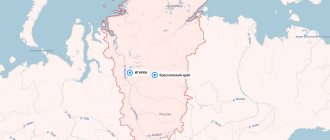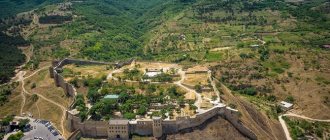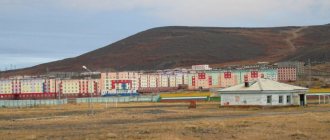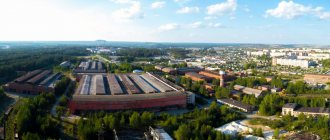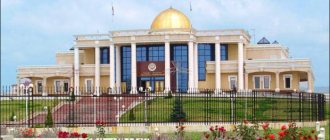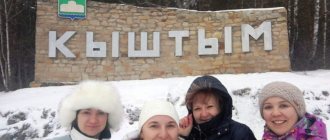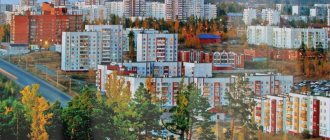Year founded: 1889
Anadyr celebrates City Day on
the 1st Saturday of August
.
In 2022,
this date is
August 6
.
Anadyr is the capital of Chukotka
Anadyr
– a port city in Russia, the administrative center of the Chukotka Autonomous Okrug. Located in the Far North, on the shores of the Bering Sea. The population of the city is more than 15 thousand people (2020).
The name of the city appears on the pages of historical chronicles in different versions: Onandyr - the Chukchi river, Anadyrsk - a fort from the time of Semyon Dezhnev (mid-17th century). In August 1889
the Novo-Mariinsk post was established at the mouth of the Kazachka River; the city of Anadyr began to develop from there. True, it became a city only in 1965. The local population still calls it Vien, which means “entrance,” or Kagyrgyn, “mouth,” which symbolizes its location in the upper part of the Anadyr estuary.
Most attractions
Anadyr is natural, but there are also a couple of interesting creations of human hands. Thus, in the city one can observe a toponymic paradox - a monument to the Orthodox Saint Nicholas the Wonderworker, located on the square named after the leader of the world proletariat Vladimir Lenin. The ten-meter-tall monument is lined with black labrodarite stone and looks harmonious next to the Cathedral of the Life-Giving Trinity. By the way, this is the largest wooden temple (its height is 25 meters) that has ever been built on permafrost, and, in addition, it is the only cathedral in the whole of Chukotka.
Cathedral of the Life-Giving Trinity (Photo: www.arcticphoto.ru) In the vicinity of Anadyr you can visit the Wrangel Island nature reserve, the Bereginya natural-ethnic park, several reserves, including Swan, Tundra and others.
On the territory of the district there is a unique crater lake Elgygytgyn of a perfectly round shape, formed about 3.6 million years ago. For most of the year its surface is covered with ice; sometimes it doesn’t have time to melt even in summer. The main holiday of Anadyr is City Day
. It is celebrated on the first weekend of August.
In addition, there are many other entertainments, each of which has its own place in the calendar. For example, in April the traditional dog sled race “Nadezhda” is held, almost 500 kilometers long. In the second half of April, residents of Anadyr say goodbye to the winter with the “Smelt Festival” - a smelt fishing competition. In the summer, since 1992, the Beriginya sailing and rowing regatta has been held, which has now become a festival of sea hunters.
Nature Reserve "Wrangel Island"
Exotic lovers, with a certain amount of luck, can appreciate the rituals of the tundra Chukchi. December 21–22 marks Pegytti, the Chukchi New Year; in January they celebrate the holiday of meeting the sun Tirkyk-emet; in February-March - Elgaatcon, dedicated to deer. The main holiday of reindeer herders, Vylgykaanmat, is celebrated from August to October: at this time, the autumn slaughter of reindeer is held with a thanksgiving ceremony.
In Chukotka and, in particular, in Anadyr, you can taste traditional dishes of the northern peoples - the Chukchi and Eskimos. The basis of their cuisine is venison, meat of sea animals, and fish. All this is usually eaten without a side dish, with bread. Currently, bay leaves, salt and black pepper are used in cooking. Stroganina made from meat and fish, yukola (dry unsalted fish), prerem (boiled and frozen venison), and kergipat (undercooked meat in its own juice) remain popular.
The best souvenir from Anadyr will be a product made by Chukotka craftsmen - bone carvers. Figures of northern animals and sculptural groups (hunting, reindeer and dog sleds) are carved from walrus tusk.
Northern calm
Residents of Chukotka give the impression of being rather reserved, not too emotional people. Another interesting trait is slowness. And why rush if everything is nearby? And no one seems to care that, due to the strange boat schedule, you can spend a whole day taking a person to the airport. No one is freaking out, no one is in a hurry. Even the governor walks the streets.
On the right is Roman Kopin, governor of Chukotka.
Anastasia Koryagina, altapress.ru
15 thousand people live in Anadyr - the same number as the Chukchi in all of Russia. For every representative of the indigenous population there are two Russians. There are also mestizos. For many Chukchi, marriage with a representative of another nationality is considered a great success. The mixing of blood, in their opinion, heals the nation.
Previously, the Chukchi practiced group marriages and offered their wives for the night to visiting people of other nationalities in order to conceive a healthy and strong child. Now these customs have disappeared.
Life in Anadyr.
Anastasia Koryagina, altapress.ru
It is believed that there are no drug problems in Chukotka. To put it mildly, importing them is problematic, and hemp does not grow in permafrost conditions. In 2016, the last officially registered drug addict left the Autonomous Okrug.
But alcoholism is thriving. Alcohol in Anadyr can only be purchased until 8 pm, and on certain dates, for example, September 1 or Indigenous Peoples' Day, not at all. There are even villages in the region where the sale of alcohol is officially prohibited, and this was done at the request of the residents themselves. The indigenous population too quickly develops an addiction to alcohol.
Life in Anadyr.
Anastasia Koryagina, altapress.ru
Wikipedia says that Anadyr is located in the border zone, but this is no longer the case. It was removed in June 2022. Now the border zone covers only the islands. This means that now you can fly to Chukotka just like that, without obtaining a pass from the border guards in advance. Residents of Anadyr complain that because of this, the city is already flooded with foreigners and migrant workers.
Life in Anadyr.
Anastasia Koryagina, altapress.ru
History of the district capital
The history of Anadyr as a city is connected with the development of the northern lands by Russians. Chukotka was discovered thanks to Semyon Dezhnev in 1648. Then the region was nicknamed Zakolymye. In 1660, on the site of the first winter hut, the Anadyr fort was founded, which was located 10 kilometers from the village of Markovo.
In 1889, researcher and doctor Leonid Grinevetsky founded the Novo-Mariinsk post in the Anadyr Okrug, placing it on the shore of the estuary. At that time, Chukchi settlements were located on these lands. The location was very convenient - the spit consisted of rubble, not swampy tundra, and was a small hill.
Gradually, the post began to grow into a village, which later became the capital of Chukotka. It was renamed Anadyr in 1924. At this time, about 200 people lived here, there was a library and a first-aid post. Ten years later, the industrial development of Chukotka began, and Anadyr became the center of the district. Its population increased to a thousand people.
The first school and pedagogical college appeared in the village. During wartime, reserve airfields were built here, and the production of edible tin began. After World War II, the settlement continued to expand: a seaport was created, a dam was built on the Kazachka River, and the first water supply system appeared. In 1965, Anadyr received city status.
Fishing place
The unemployment rate in Anadyr is low. There are all the administrative and social facilities that should be in the capital of any region. Coal, gold and silver are mined in the surrounding area. Reindeer husbandry, fishing and hunting are developed - this is mostly done by the indigenous population.
Life in Anadyr.
Anastasia Koryagina, altapress.ru
The main production in Anadyr is fish. Here you can buy the freshest chum salmon and caviar, because the fish is caught right within the city limits. The fish factory directly supplies products to the only supermarket in the city and other stores. In addition to salmon, smelt, pike, and whitefish are caught here.
Private traders catch fish with nets. Fishermen gut it right there on the shore, take out the caviar, salt it and pack it. They smoke it here, in the huts.
Fishing place in Anadyr.
Anastasia Koryagina, altapress.ru
Salmon are caught mainly for their caviar, because it can be sold profitably. Many fishermen, having caught a male, immediately throw him back into the sea. After gutting, females can be sold cheaply or given away for nothing. Or they throw it away, although this is prohibited.
It is also forbidden to exceed production standards, but most fishermen violate this prohibition. Poaching is common here, just on a different scale.
Life in Anadyr.
Anastasia Koryagina, altapress.ru
The Chukchi are an indigenous people, just like the Evens, Eskimos and Chuvans living in Chukotka. They can engage in fishing under special conditions, including catching Red List whales. Cunning Russian fish traders take advantage of this - they hire locals to work for themselves under the guise of ordinary fishermen.
Fishing place in Anadyr.
Anastasia Koryagina, altapress.ru
The city has direct flights to Moscow, Yakutsk, Khabarovsk, Magadan, and Petropavlovsk-Kamchatsky.
Having arrived at the airport (https://apanadyr.ru/), the traveler will find himself in the village of Ugolnye Kopi, which is located on the opposite bank of the estuary from Anadyr, 17 km from the city.
There are several ways to overcome a water obstacle depending on the time of year.
In summer, you can get to the other side on the Kamchatka boat. The boat runs every two hours, and from its board there is a good view of the Chukotka landscapes. A regular bus takes passengers to berth No. 10; you can also order a taxi. Then it will be possible to drive directly to your destination by car, which in this case will cross the estuary on a barge.
In winter, when the estuary freezes and navigation through it stops, you can get to the airport by taxi.
In the off-season, that is, from October to the end of December and from mid-May to the end of June, you can cross either by helicopter or by hovercraft.
When there is a storm, navigation stops and guests wait for the weather at the airport.
Anadyr is located in the permafrost zone, so almost all the buildings in it stand “on legs” - raised above the surface of the earth.
And the city is one of the most colorful in Russia. Almost all the buildings here are painted in bright colors.
Some houses still have mosaics.
On the shore where the barges carrying passengers from the airport land, there is a stele with the symbols of the city. People call it “Bon Voyage”. It depicts the coat of arms of Anadyr - a brown bear holding a red fish in its paws.
You can start your walk around the city by visiting the Great Holy Trinity Cathedral - the world's largest Orthodox wooden church built in permafrost. The building is made of pine and larch using cables tying the building according to the principle of the Ostankino TV tower in Moscow.
Near the cathedral stands the world's largest statue of St. Nicholas the Wonderworker, the patron saint of wanderers and sailors.
The bronze figure rises 10 meters above the ground, and its widely outstretched arms are more than 3.5 meters. In order for the monument to withstand strong winds, the pedestal goes into the permafrost to a depth of 15 meters.
On the shore of the estuary there is a memorial dedicated to the first Revolutionary Committee members. On the pedestal there is a figure of a man holding a banner in his hands; a little to the side of him there is a group of people of different nationalities standing shoulder to shoulder.
This is one of the most beautiful places in the city: it offers a magnificent view of the Anadyr Estuary and the seaport.
Nearby is the Museum (Lenin St., 23). This is the most recognizable building in Anadyr, made in high-tech style and resembling the silhouette of a polar bear. On three floors of the museum there are permanent and temporary exhibitions dedicated to the history, nature, and art of the region. Here you can find photographs and documents, personal belongings and traditional household items, tools, works of fine and decorative art. You can also buy souvenirs here.
On the shore of the estuary, a stela “Chukotka Front” was erected in honor of the 60th anniversary of the victory in the Great Patriotic War. The bas-reliefs tell about the residents of Chukotka who gave their lives for their Motherland. In addition, the stele depicts the route along which military aircraft were ferried from the United States and goods were supplied under Lend-Lease.
Across the road in the park there is a monument to the most famous writer of Chukotka, Yuri Rytkheu. The writer is depicted lying on a rock, with two huskies at his feet. There is a post office nearby, from where you can send postcards to friends in the country's easternmost city.
At the intersection of Otke and Mira streets there is the Church of the Transfiguration of the Lord. Walking along Mira Street, you can see the former Palace of Pioneers, as well as the monument to Vladimir Lenin, which is made of pink granite.
After seeing the main attractions of the city, you can return to the city center and relax at the Polyarny cinema (Otke St., 15). Nearby there is an art gallery where you can buy souvenirs and see exhibitions dedicated to the traditions of the northern peoples (Otke St., 33). In search of edible souvenirs, you can look into the shopping mall (Otke St., 19).
For lovers of active recreation, we can recommend the indoor skating rink, Ice Palace (Chukotskaya St., 15).
Anadyr is surrounded by hills. The closest to the city are St. Michael’s Hill and Mount St. Dionysius. The highest point of Anadyr is Camel Hill. An Orthodox cross more than 10 m high is installed here.
From here you have a magnificent view of the city.
If you find yourself in Anadyr in the summer, we recommend taking a boat trip along the waters of the Anadyr Estuary.
Anadyr also includes the national village of Tavaivaam. Local residents also engage in fishing, bone carving and selling souvenirs to tourists. Here you can buy, for example, jewelry made from walrus tusks.
White nights and cold summers
Anadyr has a harsh subarctic maritime climate. Summer is very short and cool. To a resident of the Altai Territory it may seem as if it doesn’t exist at all, and that it’s just spring smoothly flowing into autumn. On the warmest day of summer this year it was 22 degrees, on the coldest it was 2 degrees.
Weather in Anadyr.
Anastasia Koryagina, altapress.ru
In May-July the “white nights” begin here. The sun sets briefly behind the horizon, but it is still light outside all the time. You will not see the polar night, when there is no sun at all, in Anadyr. It just starts getting dark very early in winter, already at three o’clock in the afternoon. But in settlements located north of the capital, residents experience both the polar night and the polar day.
Weather in Chukotka.
Anastasia Koryagina, altapress.ru
Chukotka cannot be called a sunny region, but still there are more clear days here than in St. Petersburg. Due to its proximity to the sea, Anadyr has high humidity. In summer there is often fog, which dissipates only at 13-14 hours of the day.
The wind blows here all the time, and often cold. Local residents say that Anadyr stands on the seven winds. Because of this, even at +16 people wear jackets. Although there are “walruses” who change into shorts as soon as the sun comes out.
Life in Anadyr.
Anastasia Koryagina, altapress.ru
In winter, because of the wind, they say, sometimes the cold is unbearable. Some people use balaclavas. And in Chukotka there is the concept of “summer hat”.
Contrary to expectations, the northern lights are rare in Anadyr. In order to see this phenomenon in all its glory, it is better to go beyond the Arctic Circle, to the north.
Population
Russians make up 49.6% of the population, Chukchi - 25.3% (prevail in the Chukotka, Providensky, Iultinsky regions), Eskimos - 3% (in the east of the Chukotka, Providensky and Iultinsky regions), Evens - 2.8% (mainly . in Bilibinsky district - 11.1%), Chuvans - 1.8% (mainly in Anadyrsky district); Yukaghirs (0.4%), Koryaks (0.1%) and others also live (2010, census).
Demographic The situation is characterized by a severe reduction in population due to mass migration. outflow (main sample in the 1990s, maximum rate of over 860 per 10 thousand inhabitants in 1999): in 1990–2016 it decreased by more than 3 times. Until the beginning 2000s migrant the outflow was associated with unfavorable economic conditions. situation, in 2002 it was supplemented by a program for relocating residents to favorable climates. regarding areas. In the beginning. 2010s rate of migration losses have decreased, but still remain significant (117 per 10 thousand inhabitants, 2015). Natural is preserved. population growth (4.1 per 1000 inhabitants, 2015): birth rate 13.6 per 1000 inhabitants, mortality 9.5 per 1000 inhabitants. (9th place in the Russian Federation). Infant mortality is high (16.0 per 1000 live births; 85th place in the Russian Federation). The share of women is 49.0%; the population under working age (up to 16 years) is 22.8%, over working age – 13.2% (in the Russian Federation 24.6%). Wed. life expectancy is 64.2 years (84th place in the Russian Federation; men - 59.4, women - 69.7). Wed. density of us. 0.07 people/km2 (2016; the lowest in the Russian Federation). The majority of populated areas are concentrated around the sea. ports and located on the sea. coast. Share of mountains us. 69.2%. Large cities (thousand people): Anadyr (14.9), Bilibino (5.5), Pevek (4.7).
“You can only get there by plane”
There is not a single railway or automobile station in all of Chukotka. Because there is no need. There are no railways, and well-maintained roads are built only within populated areas. Tourists mistake the treasury building for the station in Anadyr.
Right down the street is the treasury building in Anadyr.
Anastasia Koryagina, altapress.ru
Most of the settlements in Chukotka are isolated from each other. Near the regional centers there are usually one or two small villages, to which there are dirt roads. In winter, the road network is expanded due to the construction of winter roads.
For short distances, local residents drive SUVs, self-modified all-terrain vehicles (they are often found here) or dogs. In other cases, only by water or air.
Transport in Anadyr.
Anastasia Koryagina, altapress.ru
The Kapitan Sotnikov motor ship goes to some villages of the Chukotka Autonomous Okrug from July to September. He has a special schedule that is not always followed because the weather can be bad. Tickets cost from 4,400 to 7,700 rubles, and these are preferential rates, lower than the cost of transportation. Children under 14 years old can travel at 50% of the cost, and under 7 years old for free.
Intraregional air flights are served by the airline, which flies small An-type aircraft and Mi-8 helicopters. The cost of air tickets to the villages of Chukotka varies from 3 to 12 thousand rubles. All flight numbers begin with the letters AD, and tourists constantly make fun of this at the airport.
Transport in Anadyr.
Anastasia Koryagina, altapress.ru
Air tickets to Chukotka are among the most expensive in the country. For example, I had to fly through Moscow because it was cheaper. A ticket from the capital of the country to Anadyr cost 43 thousand rubles , and back - 28 thousand rubles.
Life in Anadyr, airport.
Anastasia Koryagina, altapress.ru
Capital of Chukotka
Anadyr is the largest settlement in the district and its administrative center. It is located on the shore of the Bering Sea estuary of the same name, where the Anadyr and Kazachka rivers flow into it. A little to the west of the city is Onemen Bay. Anadyr is located on a slight rise, its center is at an altitude of 35 meters above sea level. To the southwest of it stretch vast areas of flat tundra, occasionally covered with hills.
This is one of the most remote cities in the country. Local time differs from Moscow time by as much as nine hours. Geographically, the city is much closer to Alaska than to the capital of Russia (700 km to Nome, 6192 km to Moscow).
The area of Anadyr is only 20 square kilometers. It is built up with panel and block high-rise buildings. The appearance of the city is a little unusual. All his houses are colorful and resemble a toy town. This is how they cope with the pallor of local landscapes, because a small number of sunny days and the lack of bright colors around can cause a bad mood and even depression.
Healthcare
In Ch. a. O. per 10 thousand inhabitants accounts for 71.3 doctors, persons avg. honey. personnel – 147, hospital beds – 149 (2013). The structure of the general morbidity of the population is dominated by respiratory diseases, cardiovascular diseases, injuries and poisoning (2013). The incidence of tuberculosis is 137.5 cases per 100 thousand inhabitants. (2013). Basic causes of death: cardiovascular diseases (40%), injuries and poisoning (21%), malignancies. neoplasms (10.9%), other diseases (12.6%).
Education
In the district there are (data from Chukotstat, 2015): 15 preschool institutions (3725 pupils), 42 general education institutions. educational institutions (over 7 thousand students). Operating (2016): 3 secondary professional educational institutions. education, branches - St. Petersburg. state economical University, North-East. Federal University named after M.K. Ammosova, District Public Universal Library named after. V. G. Tan-Bogoraz (1947), Museum (created in 2002 by merging the District Museum of Local Lore and the Center for the Protection and Restoration of Historical and Cultural Monuments of the Ch. A. O.), Sector for the Integrated Development of Chukotka (history dates back to 1935, modern name and status since 2013) North-East. complex research institute of the Russian Academy of Sciences - all in Anadyr.
Links[edit]
Notes[edit]
- ^ abcdefg Law No. 33-OZ
- ^ abcdef Encyclopedia of Russian Cities
. Moscow: Great Russian Encyclopedia. 2003. p. 20. ISBN 5-7107-7399-9. - ^ ab Charter of Anadyr, Article 24
- Official website of the Anadyr urban district. Mayor Autobiography archived February 3, 2014, at the Wayback Machine (in Russian)
- Rosstat. » Regions of Russia. Basic socio-economic indicators of cities. 2012 ". Far Eastern Federal District. Cities of the Chukotka Autonomous Okrug.
- ^ a b Federal State Statistics Service (2011). “All-Russian Population Census 2010. Volume 1" [All-Russian Population Census 2010, vol. 1]. All-Russian Population Census 2010 [All-Russian Population Census 2010]
. Federal State Statistics Service. - https://habstat.gks.ru/wps/wcm/connect/rosstat_ts/habstat/resources/62f1a600408e9886a05deb4d45abe5e4/Number+of+population+of the+Chukchi+autonomous+okrug+by+municipal+entity+on+1+January+ .doc ; archived date: August 31, 2022; Archive URL: https://web.archive.org/web/20190831171236/https://habstat.gks.ru/wps/wcm/connect/rosstat_ts/habstat/resources/62f1a600408e9886a05deb4d45abe5e4/%D0%A7%D0%B8% D1%81% D0% BB% D0% B5% D0% BD% D0% BD% D0% BE% D1% 81% D1% 82% D1% 8C +% D0% BD% D0% B0% D1% 81% D0 % B5% D0% BB% D0% B5% D0% BD% D0% B8% D1% 8F +% D0% A7% D1% 83% D0% BA% D0% BE% D1% 82% D1% 81% D0% BA% D0% BE % D0% B3% D0% BE +% D0% B0% D0% B2% D1% 82% D0% BE% D0% BD% D0% BE% D0% BC% D0% BD% D0% BE % D0% B3% D0 % BE +% D0% BE% D0% BA% D1% 80% D1% 83% D0% B3% D0% B0 +% D0% BF% D0% BE +% D0% BC% D1% 83% D0% BD% D0% B8% D1% 86% D0% B8% D0% BF% D0% B0% D0% BB% D1% 8C% D0% BD% D1% 8B% D0% BC +% D0% BE % D0% B1% D1% 80% D0% B0% D0% B7% D0% BE% D0% B2% D0% B0% D0% BD% D0% B8% D1% 8F% D0% BC +% D0% BD% D0% B0 + 1 +% D1% 8F% D0% BD% D0% B2% D0% B0% D1% 80% D1% 8F + 2018 +% D0% B3% D0% BE% D0% B4% D0% B0. doc.
- ^ abc Law No. 40-OZ
- Law No. 148-OZ
- "On the Calculation of Time". Official Internet portal of legal information
. June 3, 2011. Retrieved January 19, 2022. - Post office. Information and computing center of OASU RPO. ( Post office
).
Search for postal service objects ( postal Search for objects
) (in Russian) - ^ abcdef Petit Futé, Chukotka
, pp. 77ff - ^ ab Armstrong, page 53
- ^ abcdefghijk Gray, pp. 88–90
- Zhikarev, pp. 60-61
- Zhikarev, p. 63
- ↑
Dikov, s. 148 - ↑
Dikov, s. 156 - Dikov, p.151-152
- Krusdanov, s. 111
- Lebedev, Igor Aviation Lend-Lease in Russia
Nova Publishers (1997) pp.44-49 - ^ ab Estimates of Soviet Surface-to-Surface Missile Deployment, November 1965, Guided Missile and Space Intelligence Committee, Central Intelligence Agency, Washington, DC.
- Armstrong, page 187
- Gray, page 135
- https://www.newscientist.com/article/mg22329860.300-quasicrystal-quest-the-unreal-rock-that-nature-made.html#.VQoRbdFOVUY
- ^ ab Gray, page 122
- Directive No. 517-rp
- List of settlements in the Far Eastern Territory. Based on materials from the All-Union Population Census of December 17, 1926 and the Subpolar Census of 1926-27. — Khabarovsk; Blagoveshchensk, 1929
- RGAE, f. 1562, op. 336, d. 1470, l. 20.
- Census Population of the USSR 1959 archived July 19, 2011 at the Wayback Machine
- 1970 USSR Population Census Archived March 23, 2012, in the Wayback Machine
- 1979 USSR Population Census Archived March 23, 2012, in the Wayback Machine
- “All-Union Population Census of 1989. The current population of union and autonomous republics, autonomous regions and districts, territories, negative phenomena, urban settlements and rural district centers” [All-Union Population Census of 1989: current population of union and autonomous republics, Autonomous regions and districts , territories, regions, districts, towns and villages performing the functions of district administrative centers. All-Union Population Census of 1989 [All-Union Population Census of 1989]
.
Institute of Demography of the National Research University: Higher School of Economics [Institute of Demography of the National Research University: Higher School of Economics]. 1989 - via Demoscope Weekly
. - ↑
Federal State Statistics Service of Russia (May 21, 2004).
“The population of Russia, the constituent entities of the Russian Federation as part of federal districts, urban settlements, settlements, settlements of 3 thousand or more people” [Population of Russia, its federal districts, federal districts, districts, urban settlements, rural settlements - administrative centers and rural settlements with a population of more than 3,000 people] (XLS). All-Russian Population Census 2002
. - ^ ab Gray, page 126
- Gray, page 118
- ^
A project has been developed for the construction of a road from Kolyma to Anadyr. - "Weather and climate - climate of Anadyr". Weather and climate (Weather and climate). Retrieved May 13, 2015.
- "Climatic norms of Anadyr 1961–1990". National Oceanic and Atmospheric Administration. Retrieved May 13, 2015.
- (PDF). August 12, 2011 https://web.archive.org/web/20110812094031/https://bethel.govoffice.com/vertical/Sites/%7B86032ACB-92B0-4505-919A-3F45B84FECD9%7D/uploads/%7BEFEDEA86 - 3466-4370-A7D0-E88B43BA40CF% 7D.PDF . Archived from the original (PDF) on August 12, 2011. Retrieved April 18, 2022. Missing or empty |title=( help )
Sources [edit]
- Duma of the Chukotka Autonomous Okrug. Law No. 33-OZ of June 30, 1998 “On the administrative-territorial structure of the Chukotka Autonomous Okrug,” as amended. Law No. 55-OZ of June 9, 2012 “On amendments to the Law of the Chukotka Autonomous Okrug” On the administrative-territorial structure of the Chukotka Autonomous Okrug “”. Came into force ten days from the date of its publication. Published: “Vedomosti”, No. 7 (28), May 14, 1999 (Duma of the Chukotka Autonomous Okrug. Law of June 30, 1998 No. 33-OZ “ On the administrative-territorial structure of the Chukotka Autonomous Okrug”
as amended by the Law of June 9, 2012 No. 55-OZ “
On Amendments to the Law of the Chukotka Autonomous Okrug”).
"On the administrative-territorial structure of the Chukotka Autonomous Okrug" . Valid after ten days from the date of official publication.). - Government of the Chukotka Autonomous Okrug. Order No. 517-rp dated December 30, 2008 “On approval of the register of administrative-territorial and territorial entities of the Chukotka Autonomous Okrug,” as amended. Order No. 323-rp dated June 27, 2011 “On amendments to the Order of the Government of the Chukotka Autonomous Okrug dated December 30, 2008 No. 517-rp.” Published: Database “Consultant-plus”. (Government of the Chukotka Autonomous Okrug. Order No. 517-rp dated December 30, 2008 “ On approval of the Register of administrative-territorial entities of the Chukotka Autonomous Okrug”
as amended by order No. 323-rp dated June 27, 2011
On amending the Decree of the Government of the Chukotka Autonomous Okrug District dated December 30, 2008 No. 517-rp
. - Duma of the Chukotka Autonomous Okrug. Law No. 40-OZ of November 29, 2004 “On the status and boundaries of the municipal formation of the city of Anadyr, Chukotka Autonomous Okrug.” Came into force ten days from the date of official publication. Published: “Vedomosti”, No. 31 / 1 (178/1), December 10, 2004 (Duma of the Chukotka Autonomous Okrug. Law No. 40-OZ of November 29, 2004 “ On the status and boundaries of the municipal formation of the city of Anadyr, Chukotka Autonomous Okrug
Comes into force on the day following ten days after the date of official publication.) - Duma of the Chukotka Autonomous Okrug. Law No. 148-OZ of November 24, 2008 “On the status, borders and administrative centers of municipalities on the territory of the Anadyr municipal district of the Chukotka Autonomous Okrug,” as amended. Law No. 24-OZ of April 1, 2011 “On amendments to Appendix 2 to the Law of the Chukotka Autonomous Okrug” On the status, boundaries and administrative centers of municipalities in the territory of the Anadyr municipal district of the Chukotka Autonomous Okrug “”. Came into force ten days from the date of official publication. Published: “Vedomosti”, No. 46 / 1 (373/1), November 28, 2008 (Duma of the Chukotka Autonomous Okrug. Law of November 24, 2008 No. 148-OZ). On the status, borders and administrative centers of municipalities on the territory of the Anadyr municipal district of the Chukotka Autonomous Okrug
as amended by the Law of April 1, 2011 No. 24-OZ “
On amendments to Appendix 2 of the Law of the Chukotka Autonomous Okrug” “On the status, borders and administrative centers municipalities on the territory of the Anadyr municipal district of the Chukotka Autonomous Okrug"
. Valid from the day that occurs ten days after the official date of publication.). - Council of Deputies of the Anadyr Urban District. Decision No. 175 of December 8, 2010 “On approval of the new edition of the charter of the Anadyr urban district,” as amended. Decision No. 360 of May 30, 2013 “On amendments to the Charter of the Anadyr Urban District.” Came into force after official publication. Published: “Vedomosti”, No. 51 (481), December 31, 2010 (Council of Deputies of the Anadyr Urban District. Decision No. 175 of December 8, 2010 “ On approval of the Charter of the Anadyr Urban District in a new edition”
as amended by Decision dated 30 May 2013 No. 360 “
On Amendments”).
Charter of the Anadyr urban district ( comes into force after official publication). - T. Armstrong. Russian Settlement in the North
(1965) Cambridge University Press. - N. N. Dikov (N. N. Dikov). “History of Chukotka from ancient times to the present day” ( History of Chukotka from ancient
times to the present day) (1989) Moscow. - P.A. Gray. The State of the Indigenous Peoples of Chukotka: Post-Soviet Activism in the Russian Far North (2005) Cambridge University Press
- N. A. Zhikarev (N. A. Zhikarev). Essays on the History of the North-East RSFSR ( Essays on the History of the North-East RSFSR
) (1961) Magadan. - A.I. Krusdanov (A.I. Krusdanov). "Soviets in the North-East of the USSR (1962–1982): Collection of documents and materials, part 3" ( Soviets of the North-East USSR (1962–1982): Collection of documents and materials, part 3
) (1986) Magadan
Climate
The climate of the city is subarctic marine type, greatly influenced by monsoon winds, which are ensured by the change of the dominant masses - oceanic or continental. Unfavorable climatic conditions are observed here all year round: low temperatures and piercing winds. The coldest month is January. The average temperature this season is -24...-22 °C. It is worth noting that frosts are felt much sharper, as they are constantly accompanied by winds. In summer, the temperature rarely rises above +13 °C.
Precipitation is brought by air masses from the Pacific Ocean. The average annual precipitation is 200-300 mm, most of which occurs in the summer. It is this feature that ensures constant fog and cloudiness in the area.
Mass media
News agency – “Chukotka”.
The largest periodical in the district is the newspaper “Far North” (Anadyr; since 1933; weekly, about 4 thousand copies, supplement in the Chukchi language).
Radio broadcasting since 1935, television since 1967. Broadcasting of television and radio programs is carried out by the Chukotka State Television and Radio Broadcasting Company.
There are few regional Internet media - regional branches of federal online publications and aggregators (TASS, Rambler, RIA, etc.) predominate; among the regional ones there is the portal “Chukotka - a beautiful and ... harsh land.”
Music
The basis of music. cultures - folklore of Russians, Chukchi, Eskimos, Ukrainians, Evens, Evenks, Chuvans and other peoples. Among the song and dance folklore groups: “Chukchi Dawns” (founded in the early 1960s, Khatyrka village), choir “Markovskie Vecherki” (1952, Markovo village; Russian, Cossack songs; both in the Anadyr region -not), “Lorinsky Dawns” (1969, village of Lorino, Chukotka region, since 1975 people’s collective), “Above Anyuem” (founded in 1960 on the basis of the red yaranga), “Temrik” (1999, village of Keperveem; both are in Bilibinsky district). In 1957–58, the district People's House was opened in Anadyr. creativity (later repeatedly reorganized and renamed, since 2013 House of Folk Art in the Anadyr region), coordinating work to preserve traditions. adv. culture, on the basis of which district holidays and festivals are held. Under him, the State was founded in 1968. Chukchi-Eskimo ensemble "Ergyron" (Chukchi. "Dawn"; state status since 1974) - the only prof. collective, in 2000 it was recognized as a particularly valuable object of cultural heritage of the peoples of Ch. O. At the People's House creative work also includes the Eskimo folk ensemble “Atasikun” (Eskimo “All Together”; 1986, since 1990 people’s group), people’s group. collective “Folk Song Theater “Karavai”” (2006; repertoire includes Russian songs from different regions of the country). Ensembles perform at numerous venues. festivals, including the district folklore festival "Ergav" (Chukotka. "Glory"; since 1990), which takes place 1-2 times a year (was not held in 1995-99) in Anadyr and the settlements of the Bilibino, Anadyr, and Chukotka regions.
